
Asian Traditional Archery Research Network (ATARN)
Text, Illustrations and
photographs © Stephen Selby, Bede Dwyer 2002.
A1, Cloudridge,
30, Plunkett’s Road,
The Peak, Hong Kong.
Fax: (852) 2808-2887
email: srselby@atarn.org
November 2002
Dear All,
My apologies that the monthly newsletter seems to slip later and later
each month. But it is worth waiting for! This month, we have an excellent article
by Bede Dwyer on Scythian-style bows found among the mummies in the Xinjiang
Autonomous Region of China.

'Monkey
King'
I have wanted to learn the pellet bow for some time. I find it a
particularly difficult technique: you extend the arm and draw the string (a
double string with a cup to hold the pellet) back to the eye. Then just before
release, you must torque your bow-hand sharply outwards from the line of the
shot so that the pellet will not hit the grip. Doing that while maintaining
accuracy is beyond me at present. Will anyone who has experience in shooting
with pellet bows write to me (or better still, post on ATARNet) with some tips?
|
|
|
One highlight of my visit to Peking was to meet with the General
Secretary of the Chinese Archery Association, Mr Zhou Yuan. The Chinese Archery
Association is presently entirely concerned with the promotion and regulation of
FITA-rules archery in China.
However, Mr Zhou has shown keen support for research in traditional
archery – both that of the Han Chinese people and of the Chinese national
minorities such as the Tibetans, Mongolians, Xibe and Ewenki. Accordingly, the
Association will establish a "Committee for National Archery" under
its auspices. The Committee has invited me to arrange a series of 'train the
trainer' sessions in Chinese traditional archery. The sessions have been
supported by a grant from the Rotary Club of Hong Kong North, who have sponsored
the purchase of 30 bows in modern, man-made materials, suitable for initial
teaching for beginners. (I believe that initial teaching needs to start with
fiberglass bows. Once people have mastered the correct basic technique, they are
free to order horn bows from craftsmen in China and elsewhere.)
Our first training session will, appropriately, take place in December
in Qufu, the birthplace of Confucius. (Did you know that he was an archery
instructor?) The second will take place in the Spring in Nanning City, Guizhou
Province.
I am also discussing starting a training course in Chinese archery (two
hours on Sundays over ten weeks) in Hong Kong, starting in January 2003.
Csaba Grozer wrote to me asking if he could tell ATARN Members of some
new developments in his manufacture of traditional-style bows. I am passing
on Csaba's information because
I know many Members are interested in his bows; but ATARN is not an endorser
and we do not receive any payment from Csaba. I will always welcome and
publish commercial information that will be of interest to ATARN members.
OLD SCYTHIAN BOW
This bow is small and inexpensive, but it can be drawn up to 31", and
it's
fast.
HUNGARIAN BOW OF THE MIDDLE AGES
It's a great feeling to draw this bow. The string feels tight, and pulled
past a certain point it feels like it has a give to it. The bow can be drawn
up to 36" without any problem, but it also works at 28". This bow
is very
fast.
This bow is made with a special lamination technique, from special
components. On account of the special materials used, this Hungarian bow
looks like a composite Hungarian bow. It has a "C" shape when it
is
unstrung. It absorbs vibrations very well.
HUNGARIAN BOW DECORATED "A"
This bow has already existed. I made a little change in this bow.
"TRH" LAMINATED TURKISH BOW
This bow is made with a special lamination technique, from special
components. (They are neither glass or carbon fibers, nor polyester or
epoxyte.) The outer layer is a tendon-like material, and the inner layer is
a
horn-like synthetic material. On account of these materials, the bow is easy
(soft), and very fast at the same time. It has a long draw-length
(34"), and
an excellent ability to absorb vibrations.
In the 'Commercial' section of
ATARN, I'd like to advertise raw
materials for making traditional horn bows - particularly water buffalo horn,
glue and sinew. Questions about sources of supply continually get posted on
ATARNet. If you are a supplier, would you send me some advertising copy? I don't
plan to make a charge; but of course, any contribution to ATARN would be
welcome.
By
Bede Dwyer
Introduction.
This is written to give a historical context to
the information that Stephen Selby brought back from the museum in Urumqi on
some ancient bows. They have not been widely published in Chinese or English,
but they are very significant for the study of archery history.
Stephen supplied me with the descriptions, but my imagination supplied
the reconstructions. I also redrew his sketches so any errors are mine.
The
Location
Shanshan County, to the east of Urumqi, is on
the Northern Route of the Silk Road, which splits in two to pass the extremely
arid Takla Makan Desert. To the East is the Gobi Desert; to the west is the
Tarim Basin, which drains the mountains to the north. Its watercourses
eventually evaporate in the Takla Makan. Subeshi (Subeixi) is situated to the
east of the famous Silk Road town of Turpan (Turfan). Since early exploitation
by foreign archaeologists in the nineteenth and early twentieth century, the
area has continued to reveal amazing relicts of the past. Modern Chinese
archaeologists have revealed more details of the ancient inhabitants and their
ways of life. The unique dry conditions have preserved usually perishable artifacts
and even the bodies of some of the people buried there.
What have surprised many in the West were the
European features of some of the bodies. However, ancient Chinese historians had
recorded the variety of races on their northwestern border as far back as the
Han Dynasty. This area was both a trade route and the point of contact many
people from different environments and cultures. People farmed and traded in the
oases and nomads visited both for trade and warfare.
The Artifacts
Stephen Selby examined several bows in Urumqi
that were of various designs and from several periods. One type of great
significance to the history of archery was very similar to bows familiar in the
West from Greek, Persian and Scythian [i]
art. I will discuss why this is not so surprising below, but firstly I will
describe one of the bows.
The bow in question possessed a feature that is
no longer common in modern composite bows. It was thick and narrow in the
cross-section of that part of the limb where it bends. Unlike later bows, with
their broad lenticular or rectangular bending sections, this bow had a
triangular section with the apex on the belly side of the limb. The back of the
bow was slightly convex and formed the base of the triangle. At the centre of
the bow, the limbs are 4 cm wide. For a greater part of the limb it had this
unusual shape.
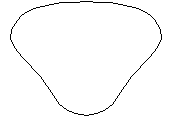
Figure 1
Cross-section of centre area of bow.
Another feature that was rare in more recent
traditional composite bows was that the tips were smoothly recurved. The
recurves had string grooves on their belly sides like modern target recurve
bows. The cross-section of the recurve was more like a slightly flattened oval.
For part of this there is a groove on one side as just mentioned. This feature
is totally unlike the bow tips on later composite bows. The term we use for bow
tips, “siyah”, is not really appropriate [ii].

Figure 2
Cross-section of recurve.
In outline, the bow looks like the Classical
Cupid’s bow of Greek and Roman art. This is not an accident. Despite being
found in the modern confines of China, this bow represents a survival of the
ancient Scythian bow, which was used from Italy in the west to the north of
China in the east. Roman armies might have carried them even further west.
Remains of later Roman archery equipment have been found in Britain, both grip
scales and laths for the ears. However, the Scythian bow would leave no telltale
laths in the archaeological records. Even in the heartland of the Scythians,
modern Russia and the Ukraine, very few identifiable remains of bows remain.
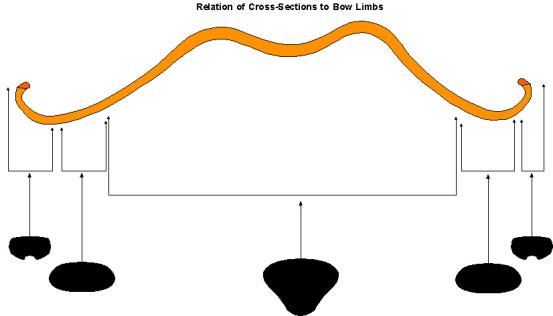
Figure 3
Subeshi Bow and Sections (Not to scale)
Stephen viewed several bows in the Museum in
Urumqi. Two in particular recall Scythian bows of the West. Both were displayed
with bowstrings and arrows of about the right length [iii],
though they may not have originally associated with these particular bows.
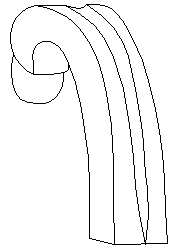
Figure 4
Simplified drawing of bow tip from belly side showing string groove
Stephen measured one bow and found that it
measured about 130 cm around the curves and 119 cm in a straight line from one
end to the other. The centre of the set back grips is 53 cm from on end and 66
cm from the other. This is a straight-line measurement. The centre of the bow
was 4 cm wide and tapered to 3.5 cm at the mid-limb. The limbs were bound with
thread [iv]
below a layer of lacquer. If the materials are really silk and Chinese lacquer,
then the use of these materials clearly suggests Chinese craftsmanship. Silk
wrapped and lacquered bows have been excavated in Warring States and Han tombs [v].
However, the bow was found in a cemetery primarily containing people of
European features [vi].
Whether the bow was finished or recovered by a Chinese artisan or complete
constructed by one is hard to say at the moment. However, Stephen advised me
that the thread could not be identified under the layer of lacquer and the
nature of the lacquer itself has not been determined yet. The bow is dated
approximately 600 BCE, but may be later. The Scythians were prominent in the
West between 750 BCE and 300 BCE. After that time they went into decline though
enclaves survived into the current era in the Crimean peninsula.
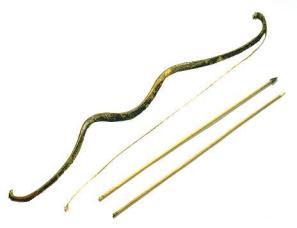
Figure 5
A Scythian style bow from Subeshi in Shanshan County, Xinjiang

Figure 6
A sketch of how a bow may have appeared strung and drawn
The sketch of the drawn bow is tentative and
almost certainly incorrect in detail. The bow would have had a greater bend
closer to the handle than I have drawn. However, the degree of this will need to
be determined by experiment. Scythian artwork often shows the parts of the limbs
I have crosshatched horizontally bent almost parallel to the arrow, as in a
Korean bow. Stephen’s
measurements of the bow indicate the stiffness of the bow was varied by reducing
the width rather than by changing the shape of cross-section. Judging by the
sections at the recurves, they may have been flexible enough to straighten out
partly at full draw. However, in art, the representations usually show a
prominent recurve at the tips when the bows are fully drawn.

Figure 7
A Western Scythian style bow reconstruction by David Betteridge
At least one of these bows was buried in a
combined bow case and quiver that the Greeks called a “gorytos” (γωρυτός
written gorytus in Latin). This piece of equipment was common from Scythia and
Greece in the West to Siberia in the East. Although there were obvious
variations between the Eastern and Western version of this equipment, they
shared a number of key features.
The quiver was attached to the outside face of
the bow case when the bow was pointing backwards.
About two-thirds of the bow was inside the case.
The arrows are usually slightly shorter than the
case, although the quiver portion of the gorytos can be shorter than the whole.
The main decoration of the gorytos is on its
outside face, the side to which the quiver is attached.
The bowstring was uppermost when the bow was in
the case unlike later bow cases for the strung bow.
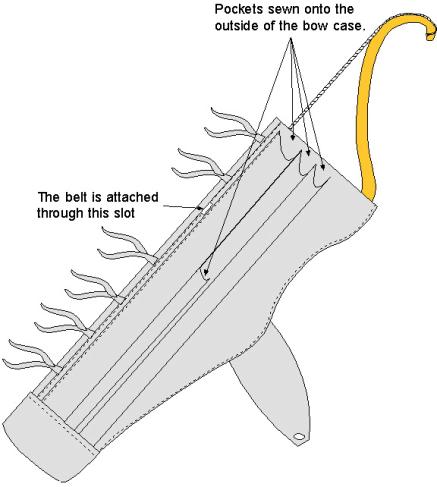
Figure 8
Drawing of a gorytos of the Eastern type
It is worth mentioning too that there are many
indications that a soft leather or cloth cover could be slipped over the upper
end of the bow to protect it from the weather. This would cover the top part of
the gorytos down to the suspension point. It is clearly shown on the Persepolis
reliefs and in many Greek vase depictions.
The leather tab on the bow case part of the
Urumqi Museum gorytos may represent another way the gorytos could be worn. If a
strap ran from the upper edge suspension point of the gorytos to the hole in the
tab, the strap could be slung over the left shoulder. This should make the
gorytos hang diagonally across the back and position the openings of both bow
case and quiver next to the right shoulder. This is pure speculation.
The Origin of the Scythians.
Warlike horse nomads are first mentioned in the West in
Assyrian documents in the eighth century BCE. These Cimmerians were eventually
over thrown by the tribes the Greeks called Scythians. They raided extensively
in the Near East and eventually allied with the Medes of western Iran to destroy
the Assyrian kingdom. According to the ancient historian, Herodotus [ix],
the Medes then murdered the Scythian leaders at a banquet and drove their forces
out of the Middle East. The Scythians retreated to the Pontic steppe through the
Caucasus. Reading the account of Herodotus, you might be excused for imagining
that the Scythians were a group of longhaired, bearded barbarians of a violent
and emotional nature, who drank the blood of their enemies and were addicted to
cannabis-laced sweat baths. However, there is much more to them than that.
The first nomads of the steppe north of the Black Sea
mentioned in the ancient historians were the Cimmerians who seem to have
originated in that area. They were early nomadic pastoralists who adopted a
stock raising, wandering lifestyle as an alternative to mixed farming. The
Scythians appeared from the east and started driving the Cimmerians before them.
The Cimmerians raided south through the passes of the Caucasus and ravaged
Anatolia. Some scholars believe that the Scythians originated in southern
Kazakhstan [x].
Therefore Scythian-style culture could have radiated east and west from a common
centre.
The Scythians were predominantly horse archers. Because
of the vast area they dominated, archaeological evidence for them is
geographically dispersed. So much so, that it would be difficult to prove racial
or linguistic uniformity, even though we can see lifestyle and artistic
continuities between these sites.
At one end of the geographical range, gold vessels
provide illustrations of the horse gear and equipment used, while at the other
end frozen tombs provide actual saddles, bridles and the corpses of horses.
Herodotus wrote about their daily life and, until the discoveries at Pazyryk in
the Altai Mountains, he was generally believed to be unreliable about the
Scythians. However, many strange details of his narrative have proved to be
true, such as hemp-enriched steam baths and the habit of scalping their enemies.
The Scythians and people in Scythian dress were widely
depicted in Ancient Greek art. The Achaemenid Persians [xi]
included eastern Scythians (the Sakas) among the tribute bearers in the
bas-reliefs at Persepolis [xii].
The bows discovered in Xinjiang are as important to the study of archery as the
frozen tombs in Pazyryk were to the general studies of the Scythians. Until
these discoveries were made, only fragments of Scythian bows and representations
could be studied. Of archery equipment, only metal fittings for the gorytos, a
combined bow case and quiver, arrowheads and a few parts of arrows survived. (I
have not included any illustrations of the typical Scythian three-bladed, bronze
arrow heads here because I do not know if any have been found in association
with these bows.)
The typical Scythian warrior was a horseman who used
archery as his prime offensive weapon. On his left side he wore a gorytos. The
arrows were typically tipped with two or three-sided bronze arrowheads. At the
western end of the steppe the arrows that survived were usually between 55 and
60 cm long [xiii]. At Pazyryk, however,
broken arrows were reassembled to suggest a length of 80 cm. From western steppe
tombs, large gold plates were excavated which were evidently the covers of the
outside faces for the wood and leather gorytoi. In art, the gorytos was usually
two-thirds to three-quarters the strung length of the bow. The gorytos plates
for which I have measurements are about 45 cm long. The whole gorytos was
probably about 55 to 60 cm long, making it about the length of the arrows found
in the same area.
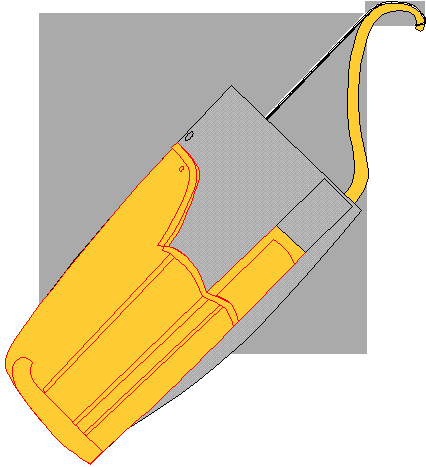
Figure 9
Simplified view of a Western Scythian Gorytos.
Another characteristic feature of the Scythians was
that they used an early form of saddle. This basic saddle consisted of two
quilted, stuffed cushions sewn to a cover with a gap down the centre between
them. Each cushion was reinforced and decorated on its front and rear faces.
This helped keep the front and rear of the saddle higher than the middle. A
strap was attached at the front and another at the rear of the cushions to
reinforce them and cover wooden spacers than kept the cushions apart. A third
strap went over the centre of the saddle and it was used to attach the girth and
the breast strap. There were no stirrups and no rigid tree to hold the shape of
the saddle. However, it was a great improvement of the basic saddle blanket,
which had been its predecessor. A felt pad was sewn underneath it and it was
usually covered with a decorative saddle cover.
These saddles are depicted in Scythian gold and silver
work from Russia and the Ukraine, in Siberian gold buckles, and on the pottery
horses of Qin Shihuangdi’s cavalry. Real examples were found frozen in the
tombs of Pazyryk [xiv] and a dried-out saddle [xv] near the burials of our
bows and gorytoi.
The Medes and some Persians are shown in the Persepolis
reliefs wearing gorytoi that are longer than those of Saka tribesmen in the same
group of reliefs. In both cases, there is a cover over the projecting part of
the bow, so details of its shape other than its profile are impossible to see.
The exception is that there is some detail of the recurvature of the bow because
the bow was strung and carried belly-up. The soft cover of the bow shows a
rounded profile. In the same group of reliefs other Persian soldiers are shown
using a longer bow without a setback handle. They carry a large shoulder quiver
instead of the gorytos.
In the collection of the Urumqi museum there are bows,
arrows and gorytoi of the longer eastern type, but obviously related to the
western Scythian equipment. Some features of the gorytos are similar to one
depicted in an architectural decoration in the old Parthian capital of Nysa in
Central Asia. Of particular interest is the use of multiple pockets for the
arrows on the outside face of the gorytos.
Some of the gold gorytos plates from Russia have
surviving bases in the form of an elongated teardrop with the narrow end facing
upwards. There is usually a ridge down the centre of the base showing the
separation of the bow case and quiver sides of the gorytos. The gorytos in the
Urumqi museum [xvi] has only a supporting
wooden rod rather than the two- or three-sided wooden frame implied by the
shapes of gorytoi in Greek and Scythian art and the gold plates with their
bases. The Nysa gorytos looks more like the Urumqi example because it has a
rounded base rather than the flat one of the Western types. This is also true of
the gorytoi on the Persepolis bas-reliefs.
The Scythian Bow.
There is a complex of weapons associated with the
Scythian lifestyle. They include the bow, arrows and gorytos. In the West the
arrows almost always had socketed, three-bladed heads and were made of bronze [xvii].
There is also a short sword called by the Greeks, an akinakes, which was worn on
the right side with the chape of the scabbard sometimes tied down to the right
thigh. Another common weapon is a narrow-bladed battle-axe with some resemblance
to the Chinese dagger-axe (ge) and ancient Near Eastern weapons. Spears and
javelins are also common in tombs. Increasingly discoveries in Eastern Europe
are adding weapons and armour to this catalogue. The use of scale armour is much
more prominent than once thought and long two-edged swords are also more
frequent.
The shortness of the bow is
an obvious convenience. Though much is made about the usefulness of short bows
on horseback, the early horse archers depicted from Assyria have medium-sized
triangular composite bows, which they drew to the right shoulder. The Qing
dynasty Manchus and the Japanese, used quite long bows and long arrows in the
last period of military horse archery. So the convenience of a short bow could
easily be overridden by other factors such as the ability to deliver a large
heavy arrow. The Assyrians moreover did not even have the advantage of the basic
saddle of the Scythians, but instead used a saddlecloth. However, the gorytos
did enable easier mounting without stirrups. It is always shown with the bow
pointing backwards when it is in use. Another feature of the short bow in the
West is the large number of arrows carried in the gorytos. The tiny bronze
arrowheads are found in numbers above fifty with the remains of gorytoi in the
Ukraine.
The recurved tips are a new
development in archery at the time, though you can see that they had ancestors.
The Assyrians and Elamites used triangular composite bows with bird’s head
shaped nocks for the strings. Since the string loop had to attach to the
bird’s beak on the back of the bow some form of basic groove was probably
carved in the tip of the bow to lead the string over. Prior to that narrowing
the tip of the bow abruptly to make two shoulders formed the string nock. On
some Ancient Egyptian bows this was carried to the extreme of having the nocks
of the bows carved into representations of Pharaoh’s enemies, their shoulders
the shoulders of the nock, their head the peg-like nock itself. Every time the
king drew his bow he strangled two of his enemies in effigy [xviii].

Figure 10
View of an Ancient Egyptian bow tip
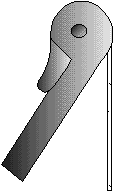
Figure 11
View of a late Assyrian bow tip.

Figure 12
View of the tip of a bow from the Achaemenid palace at Susa.
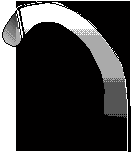
Figure 13
View of the tip of the bow from the Urumqi Museum
Set back centre sections have
been used in many places at many times, but before the introduction of the
Scythian bow, they were usually the characteristic of a bow that was under
braced. They were used to increase the bow’s power stroke on the arrow by
bringing the belly of the handgrip closer to the string. Under braced self-bows
were designed to reduce the stress on the braced bow, prolonging its life. In
the Scythian bow, they were probably introduced to shorten the draw, while still
maintaining an optimum amount of limb bending. Then
you could carry more but shorter arrows and still get good performance out of
your bow. Another effect was to increase the physical
length of the bows while retaining a short “strung’ length.

Figure 14
Cross-section based on parts of a Scythian bow from
the Three Brothers Kurgan and fragments from Sivush.
The fragments of a western
Scythian bow from the Three Brothers Kurgan [xix]
have a circular cross-section of three layers wrapped in birch bark. Other
fragments of bows are similar [xx].
This is consistent with a derivation from the ancient Near Eastern bows. Most of
the bows from Tut‘ankhamūn’s tomb are much thicker compared to their
width than we would now make a bow. While they have some reflex [xxi]
in their unbraced state, they have nothing like the reflex seen in later
composite bows. The various Greek representations of Scythians and Greeks
bracing their bows show positions that would not work with bows that are very
reflexed.
The Egyptians had separate
bow cases for their bows mounted on their chariots, but the Assyrians just
stuffed them into their quivers. In both areas, the quiver was worn on the back
when it was not attached directly to the chariot. At some stage, someone decided that a bow case attached to a
quiver would be a good idea. With the small Scythian bow and arrows, the
resulting object was not too unwieldy. The advantages were obvious: the bow was
protected from the weather and the points of the arrows.
The case also prevented the bow from being distorted, yet it was ready to
hand already strung. Drawing short arrows across the body was no great trouble
(the Plains Indians in America, when they reinvented mounted archery did a
similar thing). However, that brings us back to the Urumqi bows. Their arrows
were not short and there is some evidence that even in the West these larger
Scythian bows were in use [xxii].
The Urumqi gorytoi [xxiii]
are almost a metre long (90 cm) and the arrows are about 80 cm long. So too were
the arrows from Pazyryk. The Siberian gold belt plaques show people drawing to
the ear. Perhaps they were nearing the outer edge of utility for a gorytos.
Coupled with this large size, these gorytoi do not seem to hold as many arrows
as the smaller Western ones. This could mean that the archers needed fewer
because their larger arrows were more effective. It could also mean these were
hunting quivers and they did not have to carry many arrows. The arrows had a
mixture of wooden, horn and metal tips.
The Scythians at War.
The Scythians were primarily cavalry fighters. They
rode into battle and fought on horseback. Herodotus describes their tactics when
fighting the Persian army led by Darius the Great. They used traditional
scorched earth tactics and retreated before the large Persian army, successive
leading the Persians through each of their subject states so that their own
lands were not ravaged. After various taunts directed at the Persians, they
informed Darius that they would stand and fight if the tombs of their ancestors
were desecrated. This was the last straw for the Great King [xxiv],
who turned around and went home. Scythian horse archers had consistently
prevented the Persian army from foraging and had left Darius little choice.
This was a tale of frustration from the Persian point
of view. The Scythians effectively contained the largest army of the Middle East
and actually used it to do their own dirty work by punishing their less
enthusiastic allies. Lest we underestimate the Persians, remember that they
transported this large army from Persia through Anatolia, across the Bosphorus
on a bridge of boats, through Thrace and onto the steppe lands of Eurasia. The
logistical skills, with which they consistently underpinned their great military
expeditions, are really remarkable. However, they were outmanoeuvred by the
Scythians and confined by their swarms of horse archers.
Against a smaller army, the Scythians could be much
more aggressive and use their weapons more directly. In later years, they were a
thorn in the side for Macedonia and it took Alexander the Great to defeat their
king, Ateas. This combination of effective archery and speed of manoeuvre led to
an arms race on the steppe. Armour became popular and the Scythians themselves
eventually became victims of their more heavily armoured relatives, the
Sarmatians [xxv].
These bows are significant for two separate reasons.
They provide use with examples of how an early type of bow looked and will
eventually help us learn how it was constructed. They also show us how
widespread the Scythian steppe culture was and how the Chinese were able to
absorb some of its technical innovation. If I have spent so much time on the
Scythians, it is because this archery evidence of their presence so far east is
remarkable and it shows that the great civilisations of the world were not as
isolated from each other as we often think.
Some Questions.
There are several questions raised by these bows and
their associated equipment.
·
How were they shot? What technique was used to
draw the bow?
·
How were they constructed? What materials were
used?
·
How effective were they? How did they perform?
·
Who made them and did they influence other bows?
·
What is the relationship between the people who
were buried with these bows and the various groups living a “Scythian”
lifestyle?
Various theories have been advanced about how the
Scythians in the West shot their bows. My opinion is that the most likely is a
variation of the Mediterranean release called the Flemish release where the
index and middle fingers draw the string with the nock of the arrow between
them. I think that the existence of armguards (bracers) in some later tombs in
the area supports this view. The Western bows were so short that this grip was
necessary. Some authors have suggested a Primary Release or a Secondary Release
could have been used, but the primary release is not very strong and the
secondary is clumsy with a very short bow.
However, the bows in Xinjiang are 50% larger and not so
restrictive on the position of the fingers. In fact, there are several features
of them that generate other problems when shooting. The centre section of the
bow is 4 cm wide and would be quite a handful for most people. The
archaeological evidence suggests that the people in the cemeteries were quite
large [xxvi]
and perhaps were not inconvenienced but the large cross-section of the bow.
Unfortunately, there are no X-Rays of these bows yet
and we do not know their construction. The majority of bows seen by Stephen were
in such good condition that their internal construction is undetectable. The odd
triangular cross-section of the bow in its central parts may reflect the shape
of the horn available [xxvii]
or it might be something else entirely. There is always the possibility that the
bows are meant as grave goods only, merely full sized models of weapons. In that
case we are only looking at the form of the original. Some comments [xxviii]
can be made however. The complex shape of these bows is not likely to be
accidental or the result of parallel evolution of designs.
The most likely construction is a horn-wood-sinew
composite. The cross-section of the bow would put very high stresses on the
belly of the bow. Even with the reduction of reflex that Betteridge advances in
an upcoming paper, composite structure is about the only way to make this bow
work effectively. Of course modern bowyers could combine diverse technologies to
achieve a workable bow, but these were not available to the dwellers of Central
Asian oases before the current era.
The binding of the bow would make a major contribution
to its strength. The many changes of curvature increase the risk of the
laminations of the bow separating from each other. In modern Mongolia, some bows
are bound from end to end with transparent thread like fishing line to prevent
de-lamination. In was common in later periods to bind points of high stress with
sinew in glue as with the section of the much later bow Stephen brought back
from Xinjiang. Other resins aside from Chinese lacquer could have been used to
waterproof and protect the sinew. We will not know until one of these bows is
subjected to much more intense study.
Another part of Betteridge’s analysis implies good
performance for this shaped bow. Historical evidence mentioned above also
supports the contention that the Scythian style of bow was effective in hunting
and war. Several people already have made reproductions of Scythian bows, but as
more material is published on the Xinjiang bows, their next bows will be more
useful for estimating the range and efficiency of these ancient bows. It is up
to the bowyers to expand our knowledge in this area and I do not doubt that they
can.
I think it is likely that the bows were made locally,
but the future studies of the artefacts themselves could reverse this view.
Perhaps the materials were imported in part. Maybe Chinese craftsmen applied
lacquer and binding to previously built bows to increase their durability. At
the moment, there is just not enough evidence.
If the local people made the bows, it is likely they
represent the eastern extension of the Scythian lifestyle. However, whether this
supposition is true or the people in this area simply used bows copied from
their more nomadic neighbours is a question that requires further research. If I
use a Turkish bow, it neither makes me a Turk nor proves that I am influenced by
Turkish culture in general. I might think it is a good bow and I might even
learn to make my own.
These bows’ influence on the construction other bows
depends on their exact dating. A bronze model crossbow from the tomb of Qin
Shihuangdi [xxix] has a setback centre
like these Scythian style bows, but was it the result of influence or
convergence? It did not have recurved ends. Later bows were made with setback
handles for many centuries. However, the recurved ends of the bow were lost in
the Old World of Europe, Asia and Africa until American bowyers reintroduced
them in the 20th century. The closest bow in appearance is the Korean
composite bow, but that has a long history of its own. The extreme reflex of the
Korean bow and its entirely different cross-sections rule out much historical
connection. Though many elements of steppe culture entered the Korean peninsula
and were absorbed by the local culture, it is unlikely that this bow is
responsible for later developments in Korean archery, which probably has more to
do with native traditions combined with Ming Chinese influence.
Conclusion.
The presence of Scythian-style equipment in a cemetery
on the frontier of China is not surprising in itself. The presence of the
mummified remains of people with Western features in the area is now well known.
What is exciting from the point of view of archery is that a group of complete
early bows has been preserved. The burials in various graveyards in the
immediate area contain a range of archery equipment from various times. Because
of the widespread Scythian nomadic culture, its interaction with the various
large states on the periphery of the Eurasian steppe is significant not just for
what it says about the Scythians and their relatives. The states on the borders
of the nomadic world reacted to the threat and the military technology of their
warlike neighbours. These reactions both provide insight into the nomads and
their settled neighbours.
While the bows themselves are clearly in the orbit of
Scythian culture, if the finish is lacquer and binding, then it is closely
related the Chinese technology. In Pazyryk, the same mix of influences is
visible. Chinese mirrors and fabrics are combined in tombs with Scythian
animal-style artefacts and Near Eastern carpets. We do not know all the answers
now, but discoveries like this by archaeologists are helping us learn more. At
this stage of the investigation of the early inhabitants of Shanshan County, we
cannot be sure whether all the people buried in these cemeteries were locals or
travellers who died there. Even the dates are not precise yet. No one can
predict what will be found next in China, Siberia or Russia. Nor do we yet know
what will be discovered when more research is carried out on these amazing
artefacts.
Archery was bound up with the everyday lives of many
ancient cultures and in these bows we can see a technological bridge between the
East and the West. The Scythians and the Saka and their various relatives and
imitators represent the first major exponents of mounted pastoralism known from
history. It is entirely appropriate that their choice in bows should be so
distinctive and innovative.
Acknowledgements.
I would like to thank Stephen Selby for letting me
examine the photographs of the bows and who originally found the book from
Xinjiang mentioned below for me. David Betteridge and I have long discussed the
development of ancient composite bows and he had already started making replicas
based on the artwork and Russian excavation reports before Stephen’s
investigation. He also permitted me to use a photograph of one of his
reconstructions in progress and lent me some of his research. Edward McEwen, who
discussed also the design of the bows, provided me with the first photograph I
had seen of one. Adam Karpowicz was responsible for me seeing Chernenko’s book
and had also given me insights into the technical problems.
Further Reading.
See the Brooklyn Museum of Art for an
illustration of a gold gorytos cover.
http://www.athenapub.com/8goldnom.htm
See the Wesleyan University site for a Greek
representation of a Scythian archer holding a bow.
http://mkatz.web.wesleyan.edu/grk101/linked_pages/grk101.scythian_archers4.html
Bibliography
Andrakh, S. I., A BURIAL SCYTHIAN WARRIOR IN THE
SIVUSH AREA, 1988:1, pp. 159-170, Soviet Archaeology. (In Russian with English
summary.)
Brentjes, Burchard, WAFFEN DER STEPPENVÖLKER
(II): Kompositbogen, Goryt und Pfeil – Ein Waffencomplex der Steppenvölker,
Band 28, 1995-1996, pp. 179-210, Archaeologische Mitteilungen aus Iran. (In
German.)
Cernenko, E. V., THE SCYTHIANS 700-300 BC, 1983,
Osprey Publishing Ltd
Chernenko, E. V., SKIFSKIE LUCHNIKI, 1981,
Naukova Dumka, Kiev. (In Russian.)
Christian, David, A HISTORY OF RUSSIA, CENTRAL ASIA AND
MONGOLIA, Volume I, 1998, Blackwell Publishers Ltd.
Dubovskaya, O. R., A BURIAL OF AN ARCHER,
1985:2, pp. 166-172, Soviet Archaeology. (In
Russian with English summary.)
Herodotus, THE HISTORY, various translations.
Mair, Victor, (Editor), THE BRONZE AGE AND EARLY
IRON AGE PEOPLES OF EASTERN CENTRAL ASIA, 1998, Monograph No. 26, University of
Pennsylvania Museum Publications, ISBN 0-941694-63-1
Mallory, J. P., and Mair, Victor H., THE TARIM
MUMMIES Ancient China and the Mystery of the Earliest Peoples from the West,
2000, Thames & Hudson, London.
McEwen, Edward, Miller, Robert L., Bergman,
Christopher A., EARLY BOW DESIGN AND CONSTRUCTION, 1996, Scientific American,
June.
McLeod, W., COMPOSITE BOWS FROM THE TOMB OF TUT‛ANKHAMŪN,
1970, Tut‛ankhamūn’s Tomb Series, III, Griffith Institute, Oxford.
Phillips, E. D., THE ROYAL HORDES Nomad Peoples
of the Steppes, 1965, Thames and Hudson.
Rudenko, Sergei I., FROZEN TOMBS OF SIBERIA The Pazyryk
Burials of Iron Age Horsemen, 1970, J. M. Dent and Sons Ltd, London, originally
published in Russian in 1953.
Wang Binghua (Editor), THE ANCIENT CORPSES OF XINJIANG,
2001, translated by Victor Mair Xinjiang People’s Press, ISBN 7-228-05161-0
Yang Hong, WEAPONS OF ANCIENT CHINA, 1992, translated
by Zhang Lijing, Science Press, New York and Beijing.
Zhuo Xuejun and Ma Chengyuan (Editors), ARCHAEOLOGICAL
TREASURES OF THE SILK ROAD IN XINJIANG UYGUR AUTONOMOUS REGION, Shanghai
Translation Publishing House.
NOTES
i]
The Scythians referred to here are also called Saka by the Ancient Persians
of the Achaemenid dynasty. In Latin this became the Sacae. Though these
people were related in life styles and in language, they probably saw
themselves as distinct as the Turks and Mongols do today. It is easy from
the perspective of two millennia to see things as similar that might have
been very distinct in their time.
[ii]
“Siyah” is an Arabic word used to describe the rigid ends of a Middle
Eastern composite bow. Usually siyahs had different cross-sections than the
bending sections of the limbs. Unlike the ends of modern Korean bows there
was little bending in a siyah.
[iii]
By “right” length I mean lengths calculated from both representational
evidence, mathematical formulae and experience with other bows. The various
reports on the finding of these bows suggest they were often found with
their strings.
[iv]
Stephen suggests this could be silk. Silk binding and lacquering of bows has
been reported from China in the Warring States period. Even staff weapons
could have their shafts reinforced in that manner.
[v]
See WEAPONS OF ANCIENT CHINA, pages 95-96, where bows made of layers of
bamboo wrapped in silk and lacquered are described from Eastern Zhou tombs.
[vi]
See THE ANCIENT CORPSES OF XINJIANG, page 109, where the contents of tomb M4
cemetery No. III (3) are described briefly and there is a photograph of a
bow and arrows.
[vii]
Unfortunately for copyright reasons we cannot use both photographs, but the
bows are very similar and the drawings are a reasonable guide.
[viii]
One from Stephen Selby’s collection is illustrated on the ATARN website (www.atarn.org),
but the unusual grasp might be explained by the fact that the bow is being
used to shoot pellets.
[ix]
Herodotus of Harlicanassus in Asia Minor is sometimes called the father of
history in the West. His great book was full of ethnographic details.
Several other Greek authors wrote about the Scythians, but there is little
detail on archery.
[x]
David Christian has an excellent bibliography in A HISTORY OF RUSSIA,
CENTRAL ASIA AND MONGOLIA, which makes it much easier to look up the various
opinions on the origins of the Scythians.
They are generally thought to be Indo-Europeans speaking some sort of
Iranian language. However, the bodies from Pazyryk show both Caucasoid and
Mongoloid physical features in one population.
[xi]
Cyrus II (ruled circa 559-525 BCE) of Persia founded the Achaemenid Empire
(circa 559-330 BCE) after conquering the Medes. He was killed fighting the
Massagetae in Central Asia, neighbours of the Saka. The empire fell to
Alexander the Great several centuries later.
[xii]
Persepolis was a ceremonial capital of the Achaemenid dynasty in the
province of Persis, now Fars in Iran. Mainly Darius and his son Xerxes built
it. The surviving parts are decorated by detailed bas-reliefs of the
ceremonies that took place there. Representations of most of the peoples of
the empire have survived and their clothing or the gifts they bring to the
Great King often can identify them.
[xiii]
See A BURIAL OF AN ARCHER, SKIFSKIE LUCHNIKI and A BURIAL SCYTHIAN WARRIOR
IN THE SIVUSH AREA.
[xiv]
See FROZEN TOMBS OF SIBERIA, Chapter 6, Means of Locomotion.
[xv]
See ARCHAEOLOGICAL TREASURES OF THE SILK ROAD IN XINJIANG UYGUR AUTONOMOUS
REGION, page 105. Plate 27 and page 255 for the saddle excavated from Tomb
No. 3 of No. 1 Graveyard at Subeixi, Shanshan County, Xinjiang.
[xvii]
There is a considerable literature on these arrowheads. In the past
Soviet archaeologists have elaborately recorded their many variations.
Speculations on how they were cast and the efficiency of their production
have been fuelled by finds of moulds and unfinished arrowheads still
attached to their sprues. Some details of the procedures can be found in
SKIFSKIE LUCHNIKI. An arrow shaft generally had a small tenon carved into
its end, which fitted into the socket of the arrowhead. These heads were
small and strongly constructed though some of the sockets were only 4 mm
wide internally.
[xviii]
See COMPOSITE BOWS FROM THE TOMB OF TUT‘ANKHAMŪN, Plate XV for
examples of 21 bow tips from Egyptian tombs for more detail.
[xix]
See SKIFSKIE LUCHNIKI, page 9, Fig. 1, showing part of this bow. It may have
only been a model weapon. My cross-section is derived from this
illustration.
[xx]
See also the article in Soviet Archaeology, A BURIAL SCYTHIAN WARRIOR IN THE
SIVUSH AREA.
[xxi]
By reflex, I mean the curvature towards the back of the bow that appears
when it is unstrung. By recurve, I mean the curvature of the tips of a bow
towards the back when it is strung. These terms have been used in this
fashion in archery literature for a very long time, but occasionally they
are confused in non-archery writings. The same thing happens with the terms
composite and compound. The first means put together from separate
components like horn, wood, and sinew. The second originally meant bows made
of similar materials glued together, such as Japanese bows and some bows
from Mediaeval Russia. Nowadays it means a bow with mechanical attachments
such as eccentric pulley wheels, while the old compound bows are referred to
as being laminated.
[xxii]
Some Greek vases clearly show large Scythian bows being drawn to the ear.
The normal draw shown in the West for Scythians was only to the left nipple.
While later authors derided this short draw, it was effective at the time
and allowed for rapid shooting.
[xxiii]
See ARCHAEOLOGICAL TREASURES OF THE SILK ROAD IN XINJIANG
UYGUR AUTONOMOUS REGION, page 104, Plate 26, and page 254, for a clear
photograph and description of a gorytos associated with a bow and arrows
from Tomb No. 2 of No. 3 Graveyard at Subeixi, Shanshan County.
The bow was 121 cm long, the arrows 82 cm and the gorytos was 93 cm
by 30 cm at its widest.
[xxiv]
The Persian Emperor was called the Great King, which is a literal
translation of one of his titles. In Greek this was rendered as
‘basileus’ or king.
[xxv]
The Sarmatians have an interesting history. Herodotus referred to the
Sauromatae as the eastern neighbours of the Scythians. Whether the
Sauromatae had a name change or the Sarmatians were a sub-tribe of a
confederacy is not really clear. Several authors have contributed ideas on
the subject, but it is really beyond the scope of this article. The
bibliography of David Christian’s book has many useful references to this
problem.
[xxvi]
See THE ANCIENT CORPSES OF XINJIANG, pages 103-109, for descriptions of the
bodies. The men were sometimes over 1.8 metres tall. This evidence is
discussed in an accessible way in THE TARIM MUMMIES Ancient China and the
Mystery of the Earliest Peoples from the West. I must point out that in
Sarmatian burials, archery equipment is sometimes found in female interments
too. While I have not found evidence of this practice in Xinjiang, it is
possible that bows have been found with female bodies or that they might be.
Not having read all the published material on the graves, I am at a
disadvantage in this area of discussion.
[xxvii]
This view came from a discussion I had with David Betteridge. It was based
on the likely availability types of horn in the area. Also we discussed the
logic of the design of Scythian and the Middle Eastern bows, which preceded
them in the West. These were usually as wide as they were thick. In Egyptian
bows, the horn was not always the full width of the belly of the bow because
it was inset in a channel. The relationship of these designs to the flatter,
bamboo-based bows used in the Eastern Zhou states in China is beyond the
scope of this article.
[xxviii]
These comments are based on conversations with David Betteridge regarding
the design of Scythian bows in the West and their relationship to the bows
discussed in this article. Over several years we have been researching the
development of early composite bows. Stephen Selby has been revealing the
discoveries in Urumqi and this has made a significant contribution to our
study.
[xxix]
Stephen Selby has discussed elsewhere (http://www.atarn.org/letters/ltr_feb99.htm)
the possibility that Chinese crossbows may have used hand bows for their
prods. A feature like a setback centre section has little point in a
crossbow, but has some advantages in a hand bow. This is an additional
argument for Stephen’s thesis.
Please open a new topic on ATARNet to discuss Bede's article.
|
|
(Signed) (Stephen Selby) |